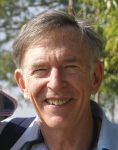
USGS emeritus geophysicist David M. Boore received the Reid Medal for his four decades of work on the prediction of strong ground motion from earthquakes.
“His contributions in the theory and practice of strong-ground motion estimation have been emulated by both earthquake scientists and earthquake engineers around the world. His scientific work has been cited more than 20,000 times; four of his papers have been cited more than 1000 times and 49 have been cited more than 100 times,” said Thomas Hanks of the USGS in his commendation, adding that Boore has “owned” the field of ground-motion seismology.
Boore’s colleagues cited his achievements in bridging the gap between theoretical seismology and practical models for earthquake engineering. Prediction of strong ground motion from earthquakes allows engineers to design or retrofit structures to withstand ground motions generated during future earthquakes.
Boore’s work in this regard includes fundamental studies to understand the causes of ground motion, as well as methods to distill these findings into critical tools such the Ground-Motion Prediction Equations (GMPEs) that are the main product of the Next Generation of Ground-Motion Attenuation Models (NGA) project. These GMPEs underlie the National Seismic Hazard maps produced by the U.S. Geological Survey, maps that are used in modern building codes.
More than 30 years ago, Boore also pioneered the stochastic ground motion model, which is used to predict strong ground motions in regions where empirical seismic data are limited. The method has been used to match ground motion measurements for earthquakes across diverse tectonic environments and more than 12 orders of magnitude. In his nomination for the award, his colleagues called the stochastic model “the most widely used seismological model for ground motions in the world.”
Boore has been consulted by numerous agencies and regulatory commissions on his strong ground motion expertise, including the U.S.-Japan Panel on Wind and Seismic Effects; the Department of Energy; as a member of panel of seismic experts for probabilistic seismic hazard analysis of the proposed Yucca Mountain waste repository, the Nuclear Regulatory Commission’s Ground Motion Guidelines project, and the Senior Seismic Hazard Analysis Committee that developed procedures for doing probabilistic seismic hazard analyses for critical facilities; and as a seismic expert for various Lawrence Livermore National Laboratory and Electric Power Research Institute studies of probabilistic seismic hazard analyses of nuclear power plant sites.
Boore received his B.S. (1964) and M.S. (1965) degrees in geophysics from Stanford University and received his Ph.D. in geophysics in 1970 from the Massachusetts Institute of Technology. He was an assistant professor at Stanford from 1972 to 1978, and then worked at the USGS from 1978 until retiring from the Survey in 2016 and continuing as Emeritus Scientist. He has served as a member of the SSA Board of Directors and as Editor and Associate Editor of the Bulletin of the Seismological Society of America.
He maintains an online catalog of his publications, updated software, notes and other seismological tools on his website (www.daveboore.com) that has become an invaluable, accessible resource to seismologists around the world.
